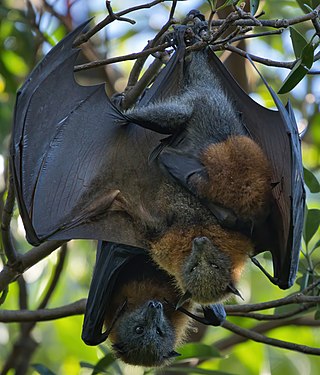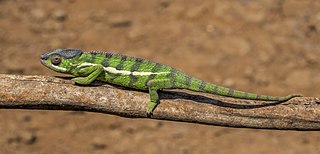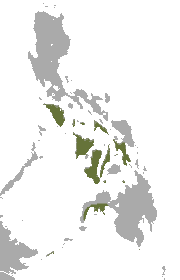
Megabats constitute the family Pteropodidae of the order Chiroptera (bats). They are also called fruit bats, Old World fruit bats, or—especially the genera Acerodon and Pteropus—flying foxes. They are the only member of the superfamily Pteropodoidea, which is one of two superfamilies in the suborder Yinpterochiroptera. Internal divisions of Pteropodidae have varied since subfamilies were first proposed in 1917. From three subfamilies in the 1917 classification, six are now recognized, along with various tribes. As of 2018, 197 species of megabat had been described.

The giant golden-crowned flying fox, also known as the golden-capped fruit bat, is a species of megabat endemic to the Philippines. Since its description in 1831, three subspecies of the giant golden-crowned flying fox have been recognized, one of which is extinct. The extinct subspecies was formerly recognized as a full species, the Panay golden-crowned flying fox. Formerly, this species was placed in the genus Pteropus; while it is no longer within the genus, it has many physical similarities to Pteropus megabats. It is one of the largest bat species in the world, weighing up to 1.4 kg (3.1 lb)—only the Indian and great flying fox can weigh more. It has the longest documented forearm length of any bat species at 21 cm (8.3 in).

The Guam flying fox, also known as the little Marianas fruit bat, was a small megabat from Guam in the Marianas Islands in Micronesia that was confirmed extinct due to hunting or habitat changes. It was first recorded in 1931 and was observed roosting with the larger and much more common Mariana fruit bat. The last specimen was a female found roosting at Tarague cliff in March 1967, but it escaped capture. An unconfirmed sighting took place sometime during the 1970s, and no other individuals have been sighted since then.

Pteropus is a genus of megabats which are among the largest bats in the world. They are commonly known as fruit bats or flying foxes, among other colloquial names. They live in South Asia, Southeast Asia, Australia, East Africa, and some oceanic islands in the Indian and Pacific Oceans. There are at least 60 extant species in the genus.

The little red flying-fox is a megachiropteran bat native to northern and eastern Australia. The species weighs about half a kilogram, one US pound, and is the smallest species of Pteropus in mainland Australia. P. scapulatus occurs at the coast and further inland, camping and flying to the tropical to temperate regions that provide them with an annual source of nectar. They exhibit an unusual method of obtaining drinking water during dry periods, skimming a stream's surface to gather it onto their fur while they are in flight.

The grey-headed flying fox is a megabat native to Australia. The species shares mainland Australia with three other members of the genus Pteropus: the little red P. scapulatus, spectacled P. conspicillatus, and the black P. alecto. The grey-headed flying fox is the largest bat in Australia.

The Mauritian flying fox, also known as Greater Mascarene flying fox or Mauritius fruit bat is a large megabat species endemic to Mauritius and La Réunion.

The black flying fox or black fruit bat is a bat in the family Pteropodidae. It is among the largest bats in the world, but is considerably smaller than the largest species in its genus, Pteropus. The black flying fox is native to Australia, Papua New Guinea, and Indonesia. It is not a threatened species.

Livingstone's fruit bat, also called the Comoro flying fox, is a megabat in the genus Pteropus. It is an Old World fruit bat found only in the Anjouan and Mohéli islands in the Union of the Comoros in the western Indian Ocean.

The wildlife of Réunion is composed of its flora, fauna and funga. Being a small island, it only has nine native species of mammals, but ninety-one species of birds.

The Indian flying fox, also known as the greater Indian fruit bat, is a species of flying fox native to the Indian subcontinent. It is one of the largest bats in the world. It is of interest as a disease vector, as it is capable of transmitting several viruses to humans. It is nocturnal and feeds mainly on ripe fruits, such as mangoes and bananas, and nectar. This species is often regarded as vermin due to its destructive tendencies towards fruit farms, but the benefits of its pollination and seed propagation often outweigh the impacts of its fruit consumption.

The great flying fox, also known as the greater flying fox or Bismarck flying fox, is a species of megabat in the genus Pteropus, found throughout lowland areas of New Guinea and in the Bismarck Archipelago. Conflicting evidence suggests that its closest relative is either the spectacled flying fox or, jointly, the Pelew and insular flying foxes. Two subspecies are recognized. At up to 1.6 kg (3.5 lb) in weight, it is among the heaviest bats in the world and the largest bat in Melanesia. It is a gregarious animal which roosts with hundreds or thousands of individuals. In part due to its wide variation in color, it has many taxonomic synonyms, including Pteropus degener, Pteropus papuanus, and Pteropus sepikensis. It may forage during the day or night in search of fruit, including figs or fruits from the family Sapotaceae. It is considered a least-concern species by the IUCN, though its numbers have been negatively impacted by what appeared to be a disease, as well as by hunting for bushmeat that occurs across its range.

The Bonin flying fox, Bonin fruit bat, or in Japanese, Ogasawara giant bat, is a species of flying fox in the family Pteropodidae. It is endemic to four islands in Ogasawara Islands, Japan. Its natural habitat is subtropical forests. It is threatened by habitat loss.

The little golden-mantled flying fox is a species of bat in the family Pteropodidae. It is found in Indonesia and the Philippines. Its natural habitat is subtropical or tropical dry forests.

The Rodrigues flying fox or Rodrigues fruit bat is a species of bat in the family Pteropodidae, the flying foxes or fruit bats. It is endemic to Rodrigues, an island in the Indian Ocean belonging to Mauritius. Its natural habitat is tropical lowland forests. The bats are sociable, roost in large groups during the day and feed at night, squeezing the juice and flesh out of fruits. They are hunted by humans for food and their numbers have been dwindling, and the International Union for Conservation of Nature has rated the species as being "endangered". In an effort to preserve them from extinction, some bats have been caught and are being bred in various zoos around the world.

The Madagascan flying fox, Madagascar flying-fox, or Madagascar fruit bat is a species of megabat in the genus Pteropus. It is endemic to Madagascar. Its natural habitats are diverse, and include moist lowland forests, dry forests, succulent woodlands, and spiny thickets, and mangroves. It eats figs and other fruits, flowers, and leaves. It is threatened by habitat loss.

The insular flying fox or Pacific flying fox is a species of flying fox in the family Pteropodidae. It is geographically widespread, the most widespread flying fox in the Pacific: it is found in American Samoa, the Cook Islands, Fiji, New Caledonia, Niue, Papua New Guinea, Samoa, the Solomon Islands, Tonga, and Vanuatu.

The large flying fox, also known as the greater flying fox, Malayan flying fox, Malaysian flying fox, large fruit bat, kalang, or kalong, is a southeast Asian species of megabat in the family Pteropodidae. Despite its scientific name, it feeds exclusively on fruits, nectar, and flowers, like the other flying foxes of the genus Pteropus. It is noted for being one of the largest bats. As with nearly all other Old World fruit bats, it lacks the ability to echolocate but compensates for it with well-developed eyesight.

The Rennell flying fox is a species of flying fox found in the Solomon Islands. It is an endangered species risking extinction.

The Christmas Island flying fox or Christmas Island fruit bat, as the name suggests, is a flying fox endemic to Christmas Island. It is unclear if it should be considered a distinct species, or a subspecies of the black-eared flying fox. It may descend from a population of island flying foxes from Pulau Panjang near Java.
























